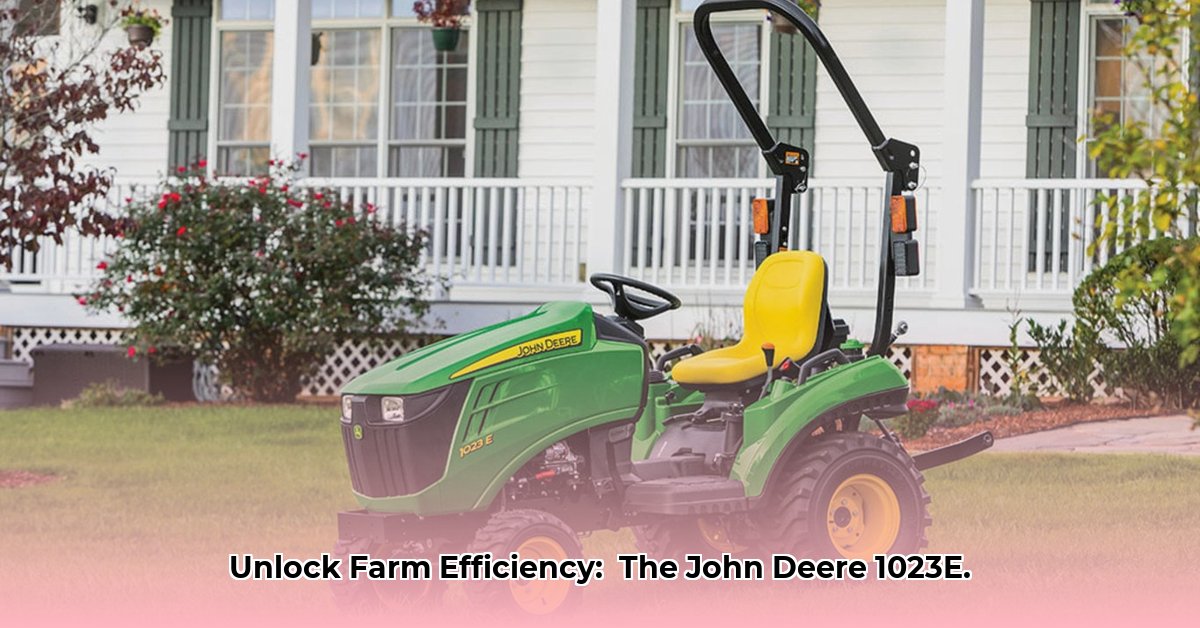
John Deere 1023E Tractor: A Comprehensive Guide for Sustainable Farming
Thinking about adding a John Deere 1023E compact tractor to your operation? This guide explores its capabilities, limitations, and best practices for maximizing its efficiency and minimizing its environmental impact. Whether you're a seasoned farmer or just starting, this in-depth analysis will help you determine if the 1023E is the right fit for your sustainable farming goals. For optimal fuel efficiency, check your tire pressure regularly.
Time Savings and Efficiency: Maximizing Your Farming Output
The 1023E’s design emphasizes efficiency. Its quick-attach system allows for rapid implement changes (mower deck, loader, tiller, etc.), minimizing downtime and maximizing your working hours. This translates directly to increased productivity. Isn't time one of your most valuable assets on the farm? How much additional work could you accomplish with even 15% more time? The 1023E’s efficiency is a key component of sustainable farming practices.
Maneuverability and Precision: Working Smarter, Not Harder
The 1023E's compact size is a significant advantage in diverse terrains and smaller farms. Its narrow width reduces soil compaction, promoting healthier soil and benefiting long-term sustainability. The precise maneuverability allows for targeted operations, reducing waste and optimizing resource use. How important is reduced soil compaction to the longevity of your land?
Versatility and Adaptability: A Multi-Tool Marvel for Your Farm
The 1023E's compatibility with a wide range of attachments makes it a versatile tool for various tasks. This adaptability streamlines operations, reducing the need for multiple pieces of equipment. Consider this: how many individual tasks could a single tractor efficiently handle compared to multiple specialized machines? This versatility directly contributes to cost-effectiveness and sustainability.
A Balanced Perspective: Strengths, Limitations, and Considerations
While exceptionally versatile for smaller farms, the 1023E's capacity may be limiting for large-scale operations. Furthermore, while initial fuel efficiency is promising, long-term studies are still needed to assess its full environmental impact. This means responsible usage and regular maintenance are essential for long-term sustainability.
Key Advantages of the John Deere 1023E: Three Pivotal Points
- Time efficiency: The quick-attach system significantly reduces downtime between tasks.
- Soil health: The compact design minimizes soil compaction, benefiting long-term land productivity.
- Versatility: A wide range of attachments allows for multiple farming operations.
Who Benefits Most from the 1023E? A Stakeholder Perspective
The 1023E offers benefits tailored to various agricultural roles:
- Small-scale farmers: Increased efficiency translates to higher yields and potentially lower labor costs.
- Agricultural Consultants: The tractor’s adaptability provides diverse application options for clients.
- Equipment Dealers: Expanded service opportunities; a growing demand for parts and maintenance.
- John Deere: Valuable customer feedback for continuous product improvement.
Addressing Potential Challenges and Mitigation Strategies
Like any machine, the 1023E faces potential issues. Proactive measures minimize risk:
- Quick-Attach Failures: Regular inspections and comprehensive operator training are crucial.
- 4WD/Power Steering Issues: Routine maintenance and preventative checks reduce the likelihood of component failures.
- PTO System Safety: Consistent inspections, safety guards, and adequate operator training are vital to prevent accidents.
- Fuel Efficiency Optimization: Explore alternative fuels and embrace efficient driving techniques.
Remember to always adhere to local safety regulations and emissions standards.
How to Optimize Fuel Consumption on Your John Deere 1023E Tractor
Fuel efficiency is a major sustainability concern. Let’s explore strategies to maximize your 1023E's fuel economy.
Leveraging the 1023E's Fuel System
The 1023E features a self-bleeding fuel system, simplifying refueling. However, regular fuel level checks are crucial. A malfunctioning fuel gauge is a common issue; consider professional calibration for accuracy.
Practical Steps for Enhanced Fuel Efficiency
Tire Pressure: Maintain proper tire inflation per the manufacturer's recommendations for optimal traction and fuel efficiency. Neglecting this can significantly increase fuel consumption.
Ballasting: Optimal ballasting (neither too much nor too little weight) ensures efficient traction and prevents wasted fuel from slippage.
Regular Maintenance: Regular oil changes, filter replacements, and radiator cleaning are essential for peak engine performance and fuel economy. Think of it as a tune-up for your car—crucial for efficiency.
Driving Techniques: Smooth operation minimizes fuel waste. Aggressive acceleration and harsh braking are fuel-guzzlers.
Appropriate Implement Use: Avoid overworking the tractor; use implements matched to its capacity to avoid unnecessary fuel expenditure.
Troubleshooting Potential Fuel System Issues
While the self-bleeding system is generally reliable, air may occasionally enter the fuel line. Reference your owner's manual to address such issues effectively.
Key Takeaways for Fuel Efficiency:
- Consistent maintenance is crucial for peak performance and reduced fuel consumption.
- Proper tire inflation and ballasting are essential for optimal traction and fuel economy.
- Smooth operation and proper implement selection are vital for maximizing fuel efficiency.
- Addressing fuel gauge inaccuracies prevents unexpected fuel depletion and ensures optimal fuel management.